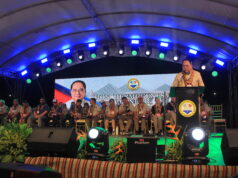ANGELES CITY – “The imperative for the Clark International Airport (CIA) to be the country’s premier inter-national gateway has all the more become acute with the sorry state of flights at the NAIA (Ninoy Aquino International Airport) of late.”
Thus said Ruperto Cruz, chairman of the multi-sectoral group Pinoy Gumising Ka Movement which has been advocating for the “full operationalization” of the CIA since 1992.
Cruz was referring to the recent delays to flights of both international and domestic carriers at the NAIA reportedly caused by air traffic congestion.
“This is what we have been crying out for so long. That the carrying capacity of NAIA has long been overstretched.
So these delays, with planes asked to go round in circles over the airport just to wait for their turns to land or wait for others to take off. God forbid, but an accident is waiting to happen there,” Cruz said.
As “quick solution” to the congestion at the NAIA, the government may force local airlines to reduce their flights.
“Right now, we are still talking to them, to get them to cut their flights voluntarily, before we bring the heavy hand of government down on them,” Transportation and Communications Secretary Manuel Roxas II said over the weekend.
According to Roxas, NAIA can only have 36 take-offs and landings because of the limited runway space but as much as 45 take-offs and landings are scheduled per hour at NAIA during peak times, leading to delays that can affect all flights for the rest of the day.
Short-sighted
Cruz has taken exception to Roxas’ “drastic but short-sighted solution” to the congestion at NAIA.
“Government need not force airlines to cut their flights. A quick solution is the transfer of some flights to Clark, thereby greatly reducing the NAIA load. It can maintain its capacity of 36 take-offs and landings and send to Clark the excess,” Cruz said.
While Roxas has acknowledged that the space at the Clark aviation complex – 2,500 hectares as against NAIA’s 600 hectares – is more than enough to meet current and future demand for flights to the Philippines, he regards the CIA as “more long-term solution.”
Roxas said the transfer of NAIA to Clark would not begin until the government concludes negotiations for a revised NorthRail contract with China.
Approved during the administration of President Gloria Macapagal-Arroyo, the previous Northrail project has been canceled by the Aquino government.
Again Cruz criticized Roxas for tying the development of the Clark airport to the Northrail project.
“We are of the belief that the failed Northrail project is a bogey being used by Roxas to prevent the CIA from being premier airport.
We sense some conspiracy here of Manila-centric imperial dragons and politicians out to get campaign funds from them to fuel their ambitions,” Cruz said. “If Roxas is indeed keen in having a rail system for Clark, then why can’t he put some drive to it?”
“A railway to Clark is not a requisite for a quick solution to the NAIA flight mess. All it takes is persuasion from government to transfer some flights to Clark,” Cruz said.
Terminal fever
The biggest detriment to Clark fully operating as international airport, according to Cruz, is the absence of a “decent, functional terminal.”
Cruz has long put the blame on the Arroyo administration and the leadership of the Clark International Airport Corp. (CIAC) for its failure to build a terminal “befitting the international-standard of Clark’s runways and taxiways.”
From the mid-point of the Arroyo’s term, Cruz said, the CIAC had proclaimed a Terminal 2 project which it said would be finished by 2010.
“Until now, we have yet to see a single hollow bock put up for that terminal,” Cruz lamented.”What we have is essentially the same terminal used by the US forces at the time Clark was their air base.”
In September 2006, President Arroyo presided over the laying of the time capsule for the construction of Terminal 2.
It was announced then that the sum of P3 billion, to come from the Manila International Airport Authority, the Philippine Amusement and Gaming Corp., and the Bureau of Immigration, among other agencies will be allotted for the project.
Nothing more was heard about it thereafter, Cruz said.
Sometime in 2008, came the $1.2 billion proposal from an ALMAL Investments Co., a subsidiary of the Kuwaiti mega developer M.A. Kharafi Projects, “to cover all civil components of the DMIA Terminals 1, 2 and 3 plus the adjacent 1,500 hectares in the aviation complex strictly following the CIAC original master plan.”
Travels to Kuwait and Egypt by CIAC officials and even Arroyo herself yielded nothing concrete.
Thereafter followed the CIAC report of a group of major government-linked and private firms in Malaysia called Bristeel Overseas Ventures, Inc. (BOV) that offered to infuse at least $150 million in foreign direct investment to immediately undertake the much-needed expansion of the passenger terminal of the Clark International Airport.
Then during its regular meeting on May 17, 2010, the CIAC Board “resolved to accept for detailed negotiations” the proposal of the Philco Aero Inc. on the Passenger Terminal 2 Development Project of the DMIA, as it was deemed “superior” to the BOVI proposal. This according to a CIAC press release.
Soon after came the reported proposal of the Metro Pacific Group of Manny V. Pangilinan expressing interest in the Clark airport.
Last January, CIAC President-CEO Victor Jose Luciano announced that the agency is pushing for the construction of a budget terminal that will handle about 10 million passengers a year at the CIA.
According to a CIAC press release, “The new facility, amounting to P12 billion, will take three years to complete and make (the CIA) the second largest airport in the country, next to Manila’s Ninoy Aquino International Airport.”
“This budget terminal is the kind of terminal that meets the requirements of our airport in Clark. Our terminal right now can only accommodate 2.5 million.
So we need a budget terminal to effectively say that DMIA is the next budget airline airport of the country.” The press release quoted Luciano.
“Once more, events have overtaken Luciano,” Cruz said, even as he expressed doubts that the purported P12-billion terminal is “just another drawing” to “cover up the conspiracy to retard the development of Clark as premier international gateway.”
“Or worse, papogi points to advance certain political ambitions and vested interests that are inimical to the people of Central and Northern Luzon,” Cruz said.




